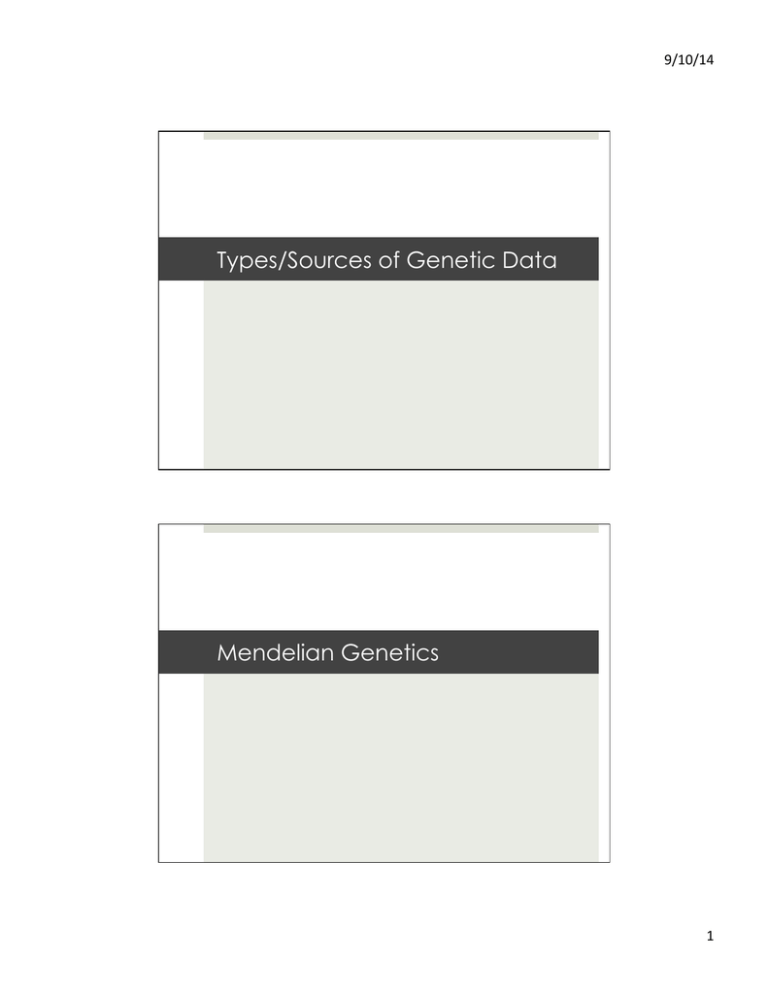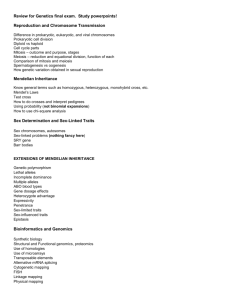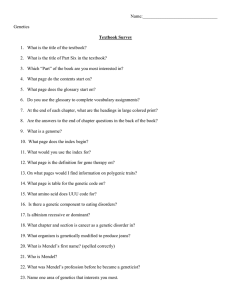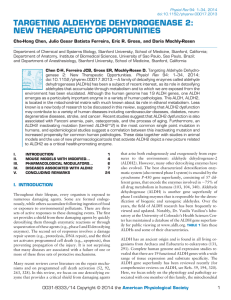Document 11743573
advertisement

9/10/14 Types/Sources of Genetic Data Mendelian Genetics 1 9/10/14 Before Mendel… ­ Problem of “blending inheritance” ² Darwin: “I have lately been inclined to speculate very crudely & indistinctly, that propagation by true fertilisation, will turn out to be a sort of mixture & not true fusion, of two distinct individuals, or rather of innumerable individuals, as each parent has its parents & ancestors.” ­ Jean-Baptiste Lamarck ² inheritance of acquired characteristics ­ Galton vs. Mendel ² continuous phenotypic variation versus discrete traits Gregor Mendel (1822-1884) ­ 1866 paper detailed results of breeding experiments on garden peas ­ observed classic ratios of discrete phenotypes in F2 generation ­ results too good to be true? ² perhaps “filtered” by Mendel ² whatʼ’s the chance of all seven traits being independent - i.e., on separate chromosomes? ­ essentially ignored until early 1900ʼ’s 2 9/10/14 Traits studied by Mendel Genetic Dominance ­ For a simple Mendelian trait determined by two alleles at one locus, the “dominant” trait/allele is “expressed” in heterozygotes ² individuals homozygous for the dominant allele and heterozygous individuals have the same phenotype ­ Dominant traits (are/do) not necessarily: ² more frequent (common) in the population ² produce bigger, stronger, faster, or more beautiful phenotypes ² produce higher fitness ­ Dominance may be incomplete (or partial) ² codominance, over-dominance, under-dominance 3 9/10/14 “Mendelian” trait with incomplete dominance ­ Snapdragon (Antirrhinum majus): cross of red and white parents yields pink “F1” individuals due to incomplete dominance v In the “F2” generations, there is a 1:2:1 ratio of phenotypes Human Mendelian traits? ­ Tongue-rolling? ² Martin NG 1975 No evidence for a genetic basis of tongue rolling or hand clasping. J. Heredity 66: 179-80. ­ albinism, polydactyly ² yes, but mutations in a number of different genes can cause these phenotypes ­ eye color, hair color, freckles ² one or a few genes of large effect, but also many modifying genes and environmental effects 4 9/10/14 Molecular population genetics ­ advent of molecular methods provided direct measures of genetic variation… ­ but also resulted in a paradoxical disconnect between genotype and phenotype… ­ a connection that is is only now being reestablished Genetic variation ­ “classical hypothesis” ² genetic variation limited and comprised primarily of harmful mutations ­ “balance hypothesis” ² abundant genetic variation is maintained by some form of balancing selection ² e.g., heterozygote advantage or frequency dependent selection ­ the two hypotheses “sat across the table glowering at each other through most of the 1950’s and 1960’s” 5 9/10/14 Mutation is the ultimate source of genetic variation ­ point mutations generate new alleles (and haplotypes) ­ also insertions, deletions, inversions, duplications (and recombination) A C G T transitions transversions Allozymes ­ early allozyme studies based on protein electrophoresis revealed unexpectedly high levels of genetic variation ² despite being an exceptionally “dull tool” for assaying genetic variation ­ presented a serious challenge to the classical hypothesis and helped stimulate work on neutral theory 6 9/10/14 Measuring genetic variation ­ Allozymes - protein electrophoresis ­ RFLPs - restriction fragment length polymorphisms ­ mini-satellites (VNTRs), microsatellites (SSRs) ² often used for paternity analysis ­ DNA sequences (esp. mtDNA: late 1980’s-2000’s) ­ SSCP - single-stranded conformational polymorphism ­ RAPDs - randomly amplified polymorphic DNA ­ AFLPs - amplified fragment length polymorphisms ­ **SNPs** - single nucleotide polymorphisms Restriction enzymes 7 9/10/14 Minisatellite DNA = “multilocus DNA fingerprinting” ² restriction digested genomic DNA hybridized to a radiolabeled probe ² probe matches highly repeated junk DNA sequence that occurs throughout the genome ² e.g., Jeffries probes 33.15 and 33.6 ² why not significant in population genetics? The Polymerase Chain Reaction (PCR) 8 9/10/14 Microsatellites Microsatellites 9 9/10/14 Microsatellites ­ Issues in µ-sat data collection ² null alleles - fail to amplify ² hidden alleles - differ in sequence but not length ­ Issues in µ-sat analysis ² mutation model - stepwise or not? ² substantial length “homoplasy” AFLPs ­ amplified fragment length polymorphism ­ advantages: ² fast survey of large number of loci ² applicable to any organism ­ disadvantages ² generally anonymous loci ² repeatability across samples? 10 9/10/14 AFLPs 11 9/10/14 “Sanger” (chain termination) sequencing with fluorescent dye terminators C C T T C C C C T T T G C A GT A C G A G C T A G G T AT T A 5' Primer 3' G G A C GCAGGCTAATGGACATCACGGGTCAGATCCGATATTTCGGGACATT |||||||||||||||||||||||||||||||||||||||||||||| TEMPLATE CGTCCGATTACCTGTAGTGCCCAGTCTAGGCTATAAAGCCCTGTAACTA...... 3' 5' GCAGGCTAATGGACATCACGGGTCAGATCCGATATTTCGGGACATTG GCAGGCTAATGGACATCACGGGTCAGATCCGATATTTCGGGACATT GCAGGCTAATGGACATCACGGGTCAGATCCGATATTTCGGGACA T GCAGGCTAATGGACATCACGGGTCAGATCCGATATTTCGGGAC A . . . GCAGGCTAATGGACATCACGGGTCAGAT GCAGGCTAATGGACATCACGGGTCAGA GCAGGCTAATGGACATCACGGGTCAG GCAGGCTAATGGACATCACGGGTC A GCAGGCTAATGGACATCACGGGT C GCAGGCTAATGGACATCACGGGT GCAGGCTAATGGACATCACGGG . . . 12 9/10/14 13 9/10/14 “Next-Gen” Methods ­ Restriction Site Associated DNA Sequencing (RAD-seq) ² Double-digest RAD-seq (ddRAD-seq) ² Type IIB RAD-seq (2b-RAD-seq) ­ Genotype by Sequencing (GBS) ­ Complexity Reduction of Polymorphic Sequences (CRoPS) ­ Sequence-Based Genotyping (SBG) ­ Multiplexed Shotgun Genotyping (MSG) 14 9/10/14 e.g., RAD-seq Genetic Basis for Human Mendelian traits? 15 9/10/14 Eye color? ­ the OCA2 gene is a principal determinant of blue versus brown eyes in Europeans, but many other genes are also correlated with eye color variation ­ Sturm & Frudakis 2004 Trends in Genetics 20: 327-332. Are there any truly discrete traits (controlled by a single-locus)? ­ in most cases in which genes of large effect are important, the phenotype is also influenced by other genes and environmental effects ­ MC1R - melanocortin 1 receptor ² a.k.a.: melanocyte-stimulating hormone receptor ² member of the G-protein-coupled receptor family ² functions at the surface of specialized pigment producing cells (melanocytes) 16 9/10/14 MC1R in birds ­ Mundy et al. 2003 Science 303: 1870-1873. ­ light and dark coloration produced by alternative alleles of MC1R in both snow geese and arctic skuas ­ but, individuals of the same genotype vary in coloration Pocket mice ­ Nachman et al. 2003 PNAS 100: 5268-5273. ­ light and dark coloration produced by alternative alleles of MC1R at Pinacate but not at Armendaris ­ independent evolution of similar phenotypes due to changes in different genes 17 9/10/14 Neanderthal MC1R ­ Lalueza-Fox et al. 2007 Science 318: 1453-1455. ­ point mutation in the Neanderthal MC1R gene suggests inactive variant that may have resulted in red hair! “Asian flush” 18 9/10/14 “Asian flush” ­ ethanol broken down to acetaldehyde by ADH (alcohol dehydrogenase), then to acetic acid by ALDH2 (aldehyde dehydrogenase) ­ “defective” ALDH2*2 allele is relatively common in Asian populations ­ reduced enzyme function due to a single amino acid substitution results in buildup of toxic acetaldehyde in the bloodstream ­ incomplete dominance: stronger effect in homozygotes than heterozygotes Functional variant (SNP) in ALDH2 gene Subject1 Subject2 Mother Grandma C T G C A G G C A T A C A C T G A A G T G A A A A C T G A G L Q A Y T E V K T E C T G C A G G C A T A C A C T A A A G T G A A A A C T G A G L Q A Y T K V K T E E = glutamic acid, K = lysine 19









